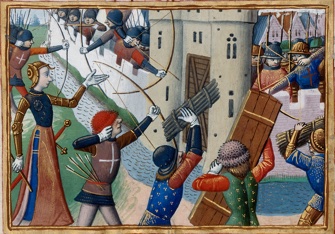
To mark the 600th anniversary of the Battle of Agincourt (Azincourt in French) and the 500th anniversary of the Battle of Marignano, the Musée de l’Armée is exploring the twin themes of knights and artillery during that one- hundred-year period in the exhibition “Knights and Bombards.”
On October 25, 1415, the English – helped notably by longbow-wielding Welshmen – defeated the French on a field churned brown with mud and red with blood in a deadly clash during the Hundred Years’ War (1337-1453). According to one anecdote, the longbowmen showed their first two fingers – the ones used to fire the arrows to slaughter the knights, horses and men at arms – in an offensive V sign to the captured French, the same

fingers that the French had boasted they would cut off the hands of the archers before the battle began.
That momentous battle still inspires debate today. In 2010, a mock trial in Washington, D.C., noted by The Guardian in a recent article, ruled that the English killing of French prisoners behind the battle lines was a war crime.
The exhibition reports that military codes at the time reserved the use of artillery for town sieges rather than the battlefield, where knights rode in full armor and men fought in close combat.
The humiliating defeat at Agincourt spurred the French king, Charles VII, to shake up the army and form an artillery regiment. Among the examples on show are mortars and cannon, along with cannonballs of stone, and lead and iron.
The cannon builders signed and sometimes decorated their work. One of the artillery pieces, dated 1474 and signed by Jean de Malines in old French, has a dog’s head sculpted on its deadly barrel. Another exhibit, the Book of Artillery, dated 1445 and drawn up in Burgundy, served as a user’s manual.
Artillery was key to helping France win back its land from the English, with firepower defeating the occupiers at the Battle of Castillon in 1453 and finally putting an end to the Hundred Years’ War.
Tucked in among the martial exhibits of swords, glittering armor, longbows and crossbows is a first folio Shakespeare manuscript, dated 1632, of Henry V, the play in which the English sovereign rallied the outnumbered and weary troops before the Battle of Agincourt with this speech: “We few, we happy few, we band of brothers; / For he today that sheds his blood with me / Shall be my brother…”
Shakespeare also refers to artillery, as Henry V urges his men once more into the breach in another English victory in 1415, the siege of Harfleur, ordering his troops to “Let pry through the portage of the head / Like the brass cannon…”
The exhibition also pays tribute to that remarkable heroine of the Hundred Years’ War, Joan of Arc, the young woman who successfully led the French into battle against the English and then was handed over to the enemy for trial and burned at the stake.
The century-long period covered by “Knights and Bombards” ends in 1515, the year of the glorious French defeat of the Swiss at the Battle of Marignano under François I, as if to prove that the French were not always on the losing side.
Favorite
